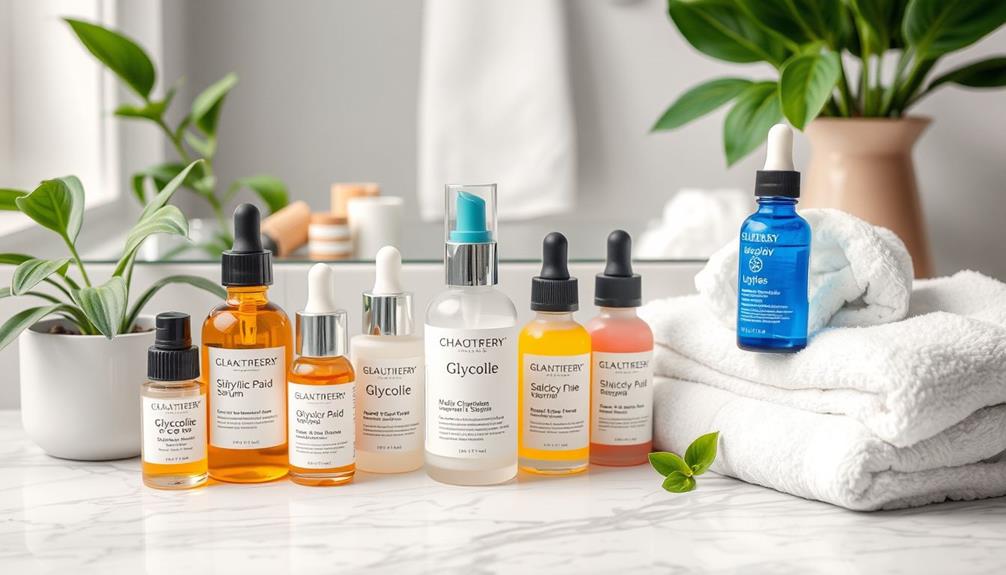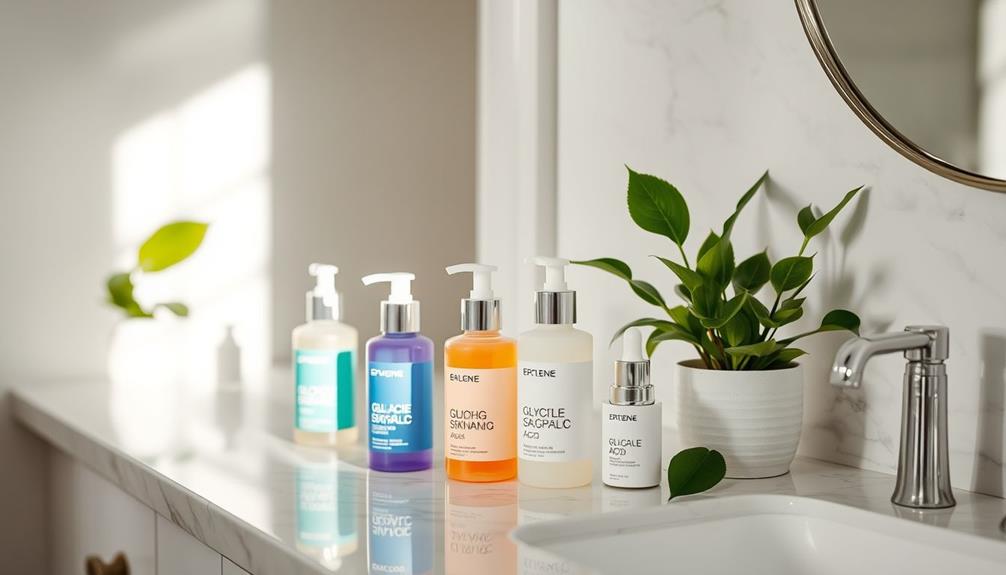Glycolic and salicylic acids make a powerful duo for achieving clear skin. Glycolic acid, an exfoliant from sugarcane, helps brighten and smooth your skin by stimulating collagen production. Salicylic acid, derived from willow bark, penetrates deep into your pores to reduce acne and improve texture. Together, they tackle surface and deeper skin issues, promoting a radiant complexion. Just be sure to start with low concentrations to minimize irritation. Alternating their use can yield the best results without over-exfoliating. Curious about the best ways to incorporate them into your routine? There's more to explore about their benefits and usage strategies!
Key Takeaways
- Glycolic acid exfoliates the skin, promoting collagen production and addressing issues like acne and hyperpigmentation for a radiant complexion.
- Salicylic acid penetrates pores to dissolve excess oil, effectively reducing acne size and preventing future breakouts.
- Combining glycolic and salicylic acids targets both surface and deeper skin concerns, enhancing overall skin clarity.
- Start with low concentrations and alternate usage to minimize irritation and prevent over-exfoliation for sensitive skin.
Understanding Glycolic Acid

Glycolic Acid, an effective exfoliant derived from sugarcane, helps you achieve clearer skin by loosening dead skin cells and promoting collagen production. This alpha hydroxy acid (AHA) works wonders for various skin concerns, including acne, hyperpigmentation, and uneven texture. Additionally, incorporating soothing ingredients like rooibos tea can help calm inflammation while you exfoliate.
When you use Glycolic Acid, you're not just exfoliating; you're also stimulating collagen, which reduces fine lines and gives your skin a youthful glow.
If you have sensitive skin, though, you need to approach Glycolic Acid with caution. While it's powerful, it can cause irritation if used incorrectly. To avoid this, start with a low concentration. Gradually increase your usage as your skin builds tolerance. This way, you can reap the benefits without overwhelming your skin.
Integrating Glycolic Acid into your skincare routine can greatly improve your complexion. Just remember to pay attention to how your skin reacts and adjust accordingly. With the right approach, you'll find that exfoliating with Glycolic Acid can lead to smoother, clearer, and healthier skin.
Understanding Salicylic Acid

Salicylic Acid is your go-to solution for tackling acne effectively. It penetrates deep into your pores to exfoliate and dissolve excess oil, leading to clearer skin.
Additionally, incorporating a holistic lifestyle approach can enhance your skin care routine, as mindful eating practices improve overall well-being.
With its anti-inflammatory properties, you'll notice a significant reduction in breakouts and improved skin texture over time.
Benefits for Acne Treatment
When you're dealing with acne, incorporating a beta hydroxy acid like Salicylic Acid into your skincare routine can greatly improve your skin's clarity and texture.
This powerful ingredient, derived from willow bark, penetrates deep into your pores to dissolve excess oil and unclog them, effectively targeting acne breakouts. At a 2% concentration, Salicylic Acid can reduce pimple size, swelling, and redness in under eight hours, offering rapid relief when you need it most.
Additionally, using essential oils in combination with your skincare regimen can enhance the benefits, as certain oils may provide therapeutic benefits that support skin health.
Its anti-inflammatory and anti-bacterial properties fight against acne-causing bacteria, making it particularly effective for treating blackheads and whiteheads.
Additionally, Salicylic Acid promotes skin cell turnover, encouraging the shedding of dead skin cells to prevent future breakouts and improve overall skin texture.
While it's highly effective, be mindful that Salicylic Acid can cause dryness and irritation, especially for sensitive skin types.
It's essential to use it in moderation and to follow up with a suitable moisturizer.
Penetration and Exfoliation Effects
Understanding how Salicylic Acid penetrates and exfoliates your skin reveals its effectiveness in combating acne and promoting a clearer complexion. As a beta hydroxy acid (BHA), it dives deep into your pores, tackling excess oil and unclogging them. Additionally, incorporating essential oils like eucalyptus and tea tree can further enhance your skincare routine, providing natural alternatives that support your skin's health. Here's how it works:
- Deep Penetration: Salicylic Acid penetrates the skin, dissolving oil and debris within your pores, making it a powerful ally against acne, blackheads, and whiteheads.
- Anti-Inflammatory Action: It reduces redness and swelling linked to acne lesions, helping your skin look calmer and clearer.
- Cellular Exfoliation: By exfoliating on a cellular level, Salicylic Acid promotes surface renewal, preventing future breakouts while enhancing the overall texture of your skin.
When combined with glycolic acid, these exfoliating agents create a dynamic duo that can greatly improve your skin's clarity.
However, be cautious—monitor your skin for sensitivity, as Salicylic Acid can cause dryness or irritation, especially if you have sensitive skin. Proper usage will lead to healthier, clearer skin that you can be proud of.
Benefits of Glycolic Acid

Glycolic acid offers numerous benefits for your skin, including effective exfoliation and improved texture, making it a powerful ally in achieving a clearer complexion. As an alpha hydroxy acid derived from sugarcane, glycolic acid works by loosening the bonds between dead skin cells, allowing them to shed more easily. This process reveals fresh, radiant skin underneath and enhances overall texture.
One of the standout features of glycolic acid is its anti-aging benefits. It stimulates collagen production, which helps reduce the appearance of fine lines and wrinkles, giving you a more youthful look. Whether you're dealing with acne, hyperpigmentation, or uneven skin texture, glycolic acid is versatile enough to tackle various skin concerns.
However, be cautious if you have dry or sensitive skin types. Glycolic acid can cause irritation, so it's wise to start with lower concentrations and gradually increase usage. This approach helps minimize sensitivity while maximizing the benefits.
Benefits of Salicylic Acid
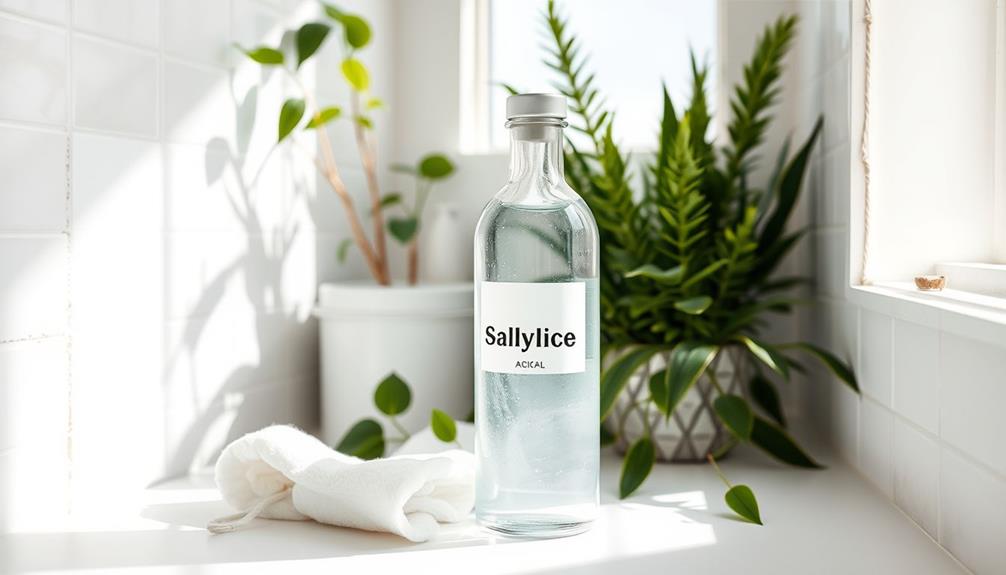
Salicylic acid complements glycolic acid's benefits by targeting acne directly, making it a powerful option for those seeking clearer skin. As a beta hydroxy acid, it penetrates deep into your pores, effectively dissolving excess oil and unclogging them.
Here are some of the key benefits of incorporating salicylic acid into your skincare routine:
- Reduces Acne: It's clinically proven at a 2% concentration to reduce pimple size and redness in under 8 hours, offering rapid results.
- Improves Skin Texture: Regular use helps exfoliate the skin, leading to a smoother and more refined skin texture over time.
- Targets Blackheads and Whiteheads: Salicylic acid's exfoliating properties make it particularly effective in treating blackheads and whiteheads, ensuring your pores stay clear.
With its anti-inflammatory properties, salicylic acid also reduces redness and swelling associated with acne breakouts.
Can They Be Combined?

Combining glycolic and salicylic acids can create a powerful skincare routine, addressing both surface and deeper skin concerns effectively. Glycolic acid exfoliates the skin's surface, while salicylic acid penetrates pores to tackle issues like acne and texture. Using these acids together can greatly improve your skin tone and texture, as glycolic enhances exfoliation while salicylic unclogs pores.
However, it's crucial to be cautious. Combining glycolic and salicylic acids may increase the risk of skin irritation, particularly if you have sensitive skin. To minimize this risk, start with low concentrations and gradually increase usage. You might also consider alternating between the two acids on different days. This approach helps prevent over-exfoliation and keeps irritation at bay.
Before diving into a routine with these acids together, consulting a dermatologist is a smart move. They can provide tailored advice based on your specific skin type and concerns, ensuring you get the best results without compromising your skin's health.
Frequency of Use

How often you use glycolic and salicylic acids can greatly impact your skin's clarity and health. It's essential to find the right frequency of use that suits your skin type, especially if you're sensitive. Here are some guidelines to help you:
- Glycolic Acid: Use it 2-3 times a week. This frequency allows your skin to benefit from its exfoliating properties without becoming irritated.
- Salicylic Acid: Apply it 1-2 times a week. It targets acne and helps unclog pores, balancing your regimen without overwhelming your skin.
- Adjust Gradually: Start with lower concentrations and gradually increase the frequency of use as your skin acclimates. Monitor how your skin reacts, and if you notice any signs of sensitivity, scale back.
Tips for Effective Pairing

When pairing glycolic and salicylic acids, it's important to start with low concentrations to avoid irritating your skin. This is especially significant if you have sensitive skin, as both acids can be potent.
Begin by using each acid on alternate days. For example, use Glycolic Acid one day and Salicylic Acid the next. This approach helps prevent over-exfoliation while allowing your skin to gradually adjust to the treatment.
Pay close attention to how your skin responds. If you notice any irritation, consider reducing the frequency or concentration of the acids. It's necessary to find a balance that works for your unique skin type.
After applying either acid, always follow up with a moisturizer to keep your skin hydrated. Additionally, applying sunscreen during the day is crucial, as these acids can increase your skin's sensitivity to the sun.
If you're unsure about how to combine these acids effectively, don't hesitate to consult a dermatologist. They can provide personalized advice tailored to your specific concerns, ensuring you achieve the best results without compromising your skin's health.
Potential Skin Reactions

When using glycolic and salicylic acid, you might notice some common side effects like redness or stinging, especially if you have sensitive skin.
It's important to pay attention to how your skin reacts, as over-exfoliation can lead to dryness and increased sensitivity.
Starting with lower concentrations can help you gauge your skin's tolerance while minimizing potential irritation.
Common Side Effects
Using glycolic and salicylic acid can lead to common side effects like skin sensitivity, irritation, and dryness, especially for those with sensitive skin. It's essential to be aware of how your skin reacts when you incorporate these potent ingredients into your routine.
Here are three common side effects you might experience:
- Skin Sensitivity: Both acids can increase your skin's sensitivity, making it more reactive to environmental factors like sun exposure.
- Irritation: You may notice redness or a mild tingling sensation during application. While mild tingling is generally normal, persistent irritation is a sign to reassess your routine.
- Dryness and Peeling: Salicylic acid can cause dryness and peeling as it dissolves excess oil, which can disrupt the skin barrier if overused.
To minimize these common side effects, start with low concentrations of both acids and gradually increase usage. This approach helps your skin adjust, reducing the risk of irritation and other unwanted reactions.
Always listen to your skin, and if reactions persist, consider consulting a dermatologist.
Skin Sensitivity Considerations
Incorporating glycolic and salicylic acids into your skincare routine can heighten skin sensitivity, particularly for those with dry or sensitive skin types. While these acids are effective for achieving clear skin, they can also lead to potential irritation or redness.
The exfoliating properties of both acids mean that over-exfoliation is a real concern, especially if you don't monitor your usage carefully. To minimize adverse reactions, start with lower concentrations and gradually increase as your skin builds tolerance.
You might experience a mild tingling sensation upon application, which indicates effectiveness. However, if you feel excessive stinging or burning, it's important to discontinue use immediately.
After applying these acids, always follow up with a good moisturizer and sunscreen. Increased sun sensitivity can occur due to their exfoliating properties, making sun protection essential for maintaining healthy skin.
Recommended Products
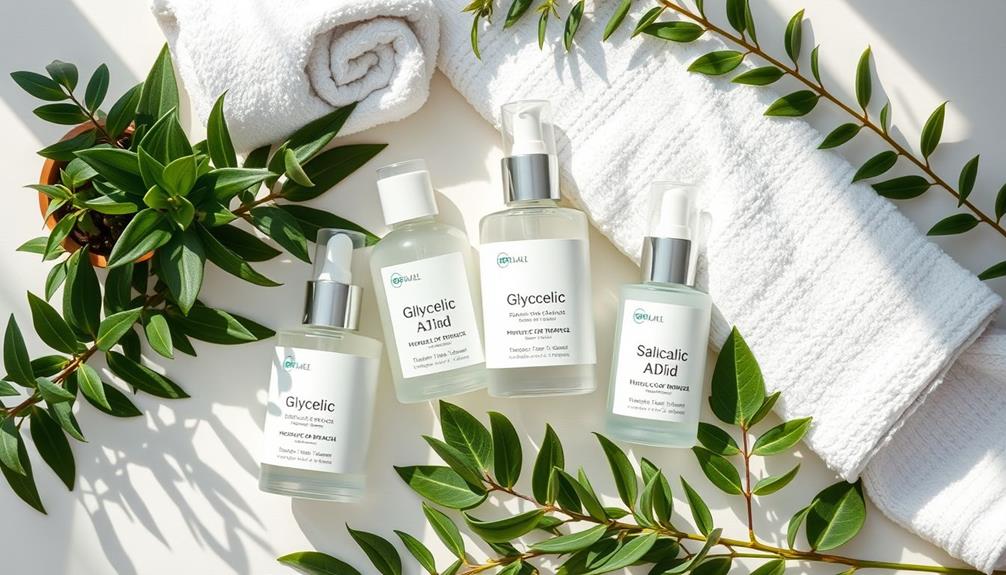
Explore these top-rated products that blend Glycolic and Salicylic Acids to help you achieve clearer, healthier skin. Incorporating these acids into your skincare routine can greatly improve your skin texture and clarity. Here are three standout products you should consider:
- Clear Skin AHA BHA Exfoliating Cleanser: This cleanser combines Glycolic and Salicylic Acids with Jojoba Beads for gentle exfoliation, making it suitable for all skin types while promoting a brighter complexion.
- Derma-TX Glycolic & Salicylic Power Peel: A potent blend of acids, this peel is aimed at rejuvenating your skin. It's perfect for reducing enlarged pores and addressing visible signs of aging. Use it once or twice a week for best results.
- Rapid Clear 2-in-1 Fight & Fade Toner: Featuring a 2% concentration of both Salicylic and Glycolic Acids, this toner effectively reduces acne and post-acne marks within just eight hours, ideal for oily skin types.
Professional Guidance
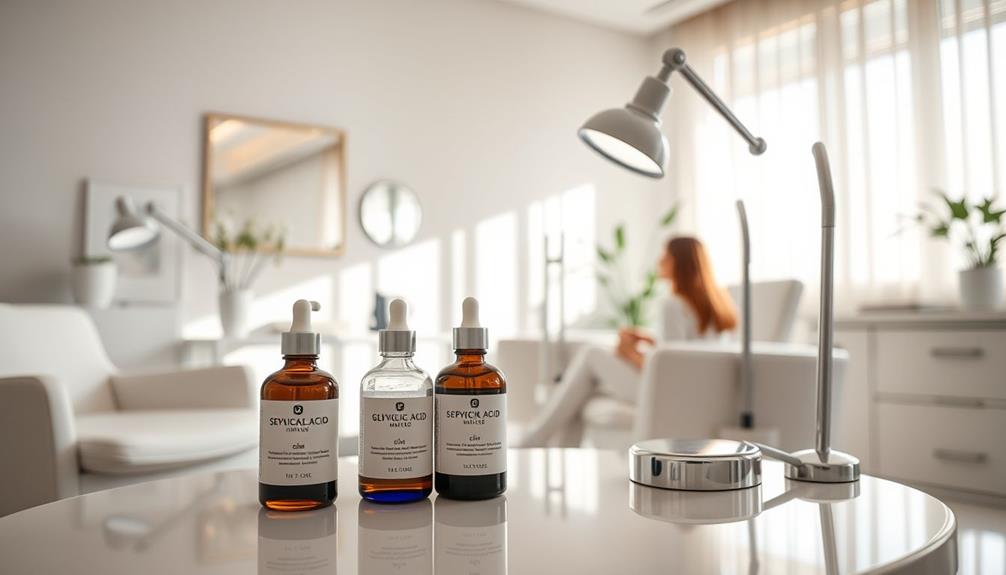
Seeking professional guidance is vital to safely and effectively incorporate glycolic and salicylic acids into your skincare regimen. Consulting a dermatologist is particularly important for individuals with sensitive skin or pre-existing conditions. They can recommend starting with low concentrations of both acids to minimize irritation while gradually increasing usage as tolerated.
Dermatologists often suggest alternating days for applying these acids to prevent over-exfoliation and protect your skin barrier. Monitoring skin reactions is significant; if you experience excessive dryness, redness, or irritation, a professional can help tailor your skincare routine accordingly.
Here's a quick reference table to summarize best practices:
| Step | Action | Purpose |
|---|---|---|
| Consultation | Schedule a visit with a dermatologist | Guarantee safety and personalized advice |
| Start Low | Use low concentrations initially | Minimize irritation |
| Alternate Use | Apply acids on different days | Prevent over-exfoliation |
| Monitor | Track skin reactions | Adjust routine as needed |
Conclusion
So, there you have it—glycolic and salicylic acid, the dynamic duo your skin's been waiting for!
If you think juggling two acids is risky, think again; it's not like you're trying to balance a flaming sword on a unicycle.
With the right tips and products, you can achieve that coveted clear complexion without the drama.
Just remember, your skin isn't a chemistry experiment—don't turn your face into a science fair project gone wrong!
